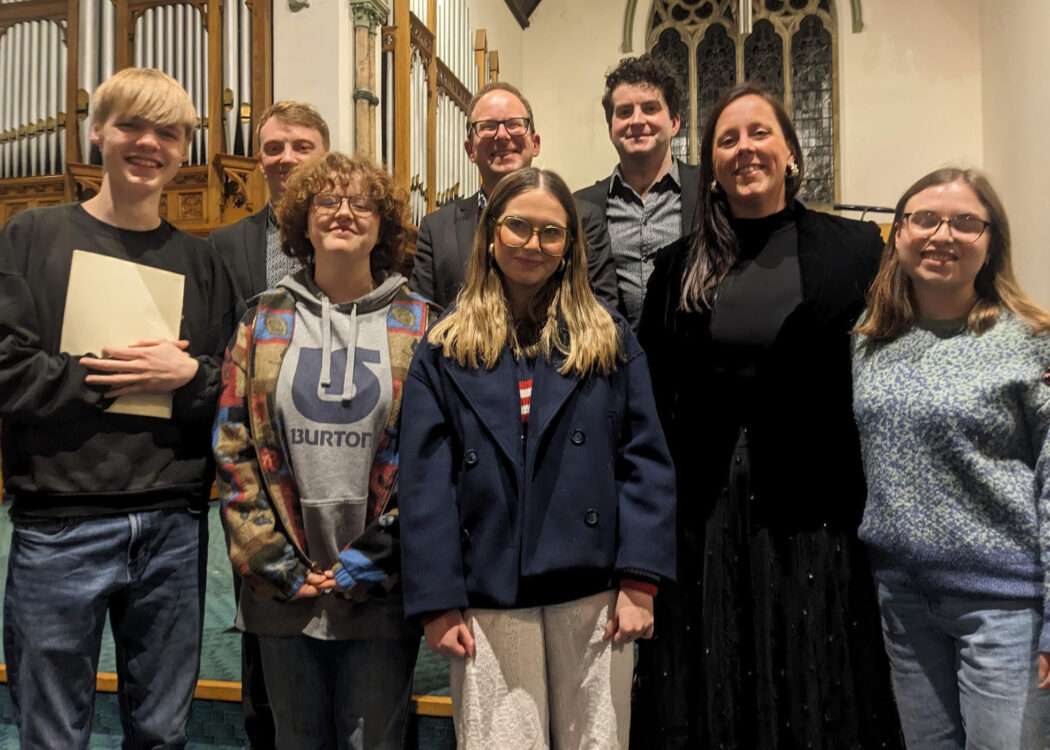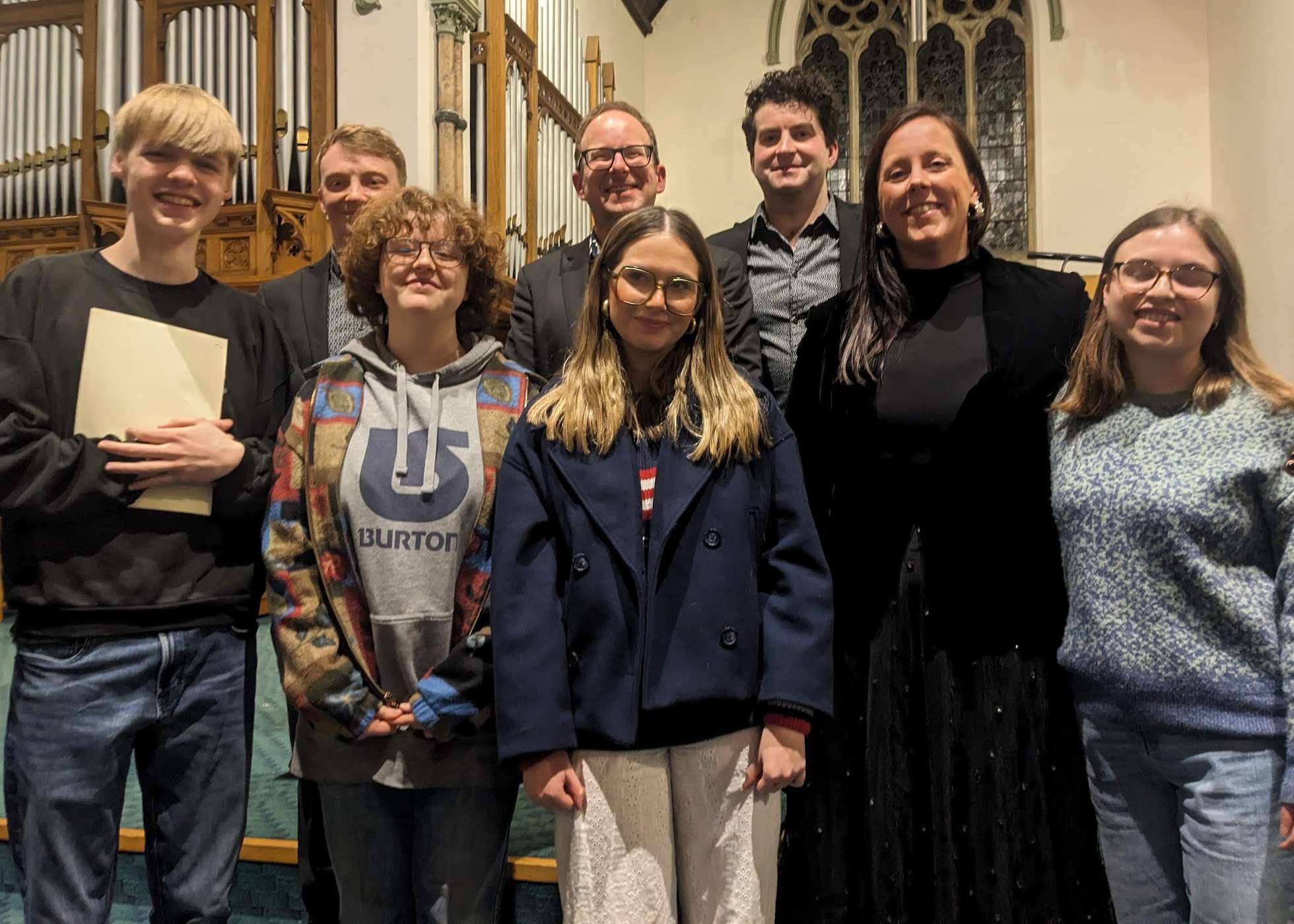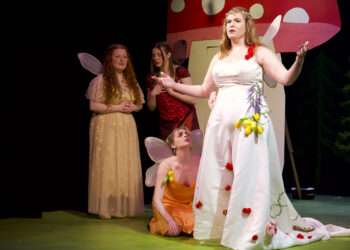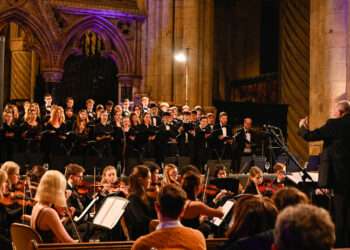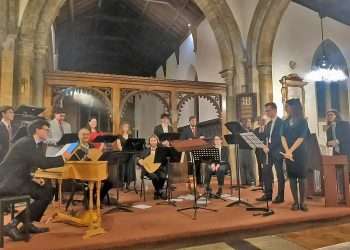EXAUDI vocal ensemble presented another dazzling concert for Musicon last night, in which very old and very new pieces reflected and illuminated each other.
On paper it was esoteric stuff – vocal music by fourteenth century composers who were going wild in the toybox of musical notation and stretching it to breaking point. Angelorum psalat by Rodericus is apparently so complex that academic wars are still being fought over how to transcribe it, and it is rarely performed. Le ray au soleyl by Johannes Ciconia is a ‘puzzle canon’ which was offered to us in several different solutions and La harpe de melodie by Jacob Senleches is literally written in the shape of a harp. And that’s before we even get to Scribe by Mark Dyer in which AI was trained to read the early fifteenth century Old Hall Manuscript and generate new manuscripts and music which Dyer then edited and transcribed. (Read more here about this fascinating project cyborgsoloists.com/scribe )
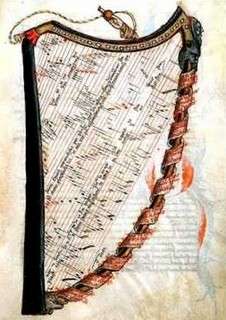
One might easily suspect that this sort of extreme musicology could become an end itself, with no great concern for what the results actually sound like. But hearing this music, particularly in the expert hands of EXAUDI and James Weeks, made me glad that people have made these strenuous efforts to recreate it, because once liberated from those dusty parchments (or computer chips) it was utterly glorious. The independent and often very different vocal lines twisted companionably around each other and the brain-bendingly complex rhythms felt natural and fluid – particularly in the Rodericus piece, sung by Eleanor Bray and David de Winter. However, I would have liked to had some idea of what the texts meant. Each syllable was stretched out across so many notes that although it was exquisitely beautiful and very absorbing, it was all quite abstract.
The music in the first section of the programme was based mostly around the intervals of fourths and fifths, creating a sparse, austere texture, enhanced by the cut-glass clarity of the six singers. Then before Mark Dyer’s piece we had a sudden sugar rush in the form of three pieces from the Old Hall Manuscript which illustrated England’s first great contribution to Western classical music – the introduction to the harmony of the third, adding sweetness and warmth to the musical texture. Leonel Power’s Beata progenies and Bytterling’s Nesciens mater were gentle but Pycard’s five-part Gloria erupted into a joyful, chaotic swirl.
Mark Dyer’s Scribe was disorienting. I confess that I didn’t have time to read the programme notes before hearing it and, introducing it, EXAUDI’s director James Weeks played along with the fiction that this was a recently rediscovered piece by an obscure composer called Marel le Gan (a play on the Generative Adversarial Network technique that generated the music). This music felt different. There were more gaps in the texture, as if the mirror had been shattered into shards and pieced back together. There were strange harmonies and I noticed repeated, hypnotic patterns in little cells that felt more like modern minimalism. Realising afterwards that this was created through machine learning, this all made sense, but I greatly enjoyed the concept and the fiction and I’m also glad that I only realised afterwards what it was all about.
There was nothing fictitious about the next section of the programme, as the composers were all sitting in the front row and looking justifiably excited. This is the second year of a fantastic collaboration between EXAUDI and St Leonard’s School, supported by Durham Music Service, in which the ensemble perform pieces written for them by the school’s A-level music students. As last year, I was astounded by the results – accomplished, imaginative pieces and all very different responses to the remit.
Kare eda ni by Jonathan Woods is a setting of a Japanese haiku. Its sparse texture reflected the clarity of Japanese poetry and in programming terms, linked nicely to what had gone before. When I talked to the composers afterwards, I was not surprised to learn that Jonathan had composed specifically with EXAUDI’s sound and repertoire in mind after hearing last year’s concert – evidence of the growing depth of this partnership.
Ruth Allison chose Shakespeare’s Sonnet 130 (‘My mistress’s eyes are nothing like the sun’) throwing the text cleverly back and forth in echoes and counterpoint between the male and female voices, as if the lady was questioning what her partner was saying to her – but the lovers were reconciled in the warmth of the ending.
There was a suitably spiky, bristling texture to Cole Bagley’s setting of Emily Brontë’s Love and Friendship, which uses roses and holly bushes as metaphors, with the piece pulling up sharply on ‘but’ to emphasise the contrasting ideas – and although I didn’t know this poem, the clarity of both the musical writing and EXAUDI’s delivery illustrated it beautifully.
Rounding off the music from St Leonard’s in delightful style was Daisy Burlison’s breezy, jazzy setting of Love’s Philosophy by Percy Bysshe Shelley, with a catchy tune and a sweetly flirtatious approach to the text.
From these brand new pieces, EXAUDI swung us right back through the centuries for the earliest music on the programme – three songs by the undisputed master of courtly love, Guillaume de Machaut. (Apparently he was in no doubt of his talent, ensuring that his music survived seven centuries by making sure it was written on beautiful manuscripts of the highest quality). Très douce dame, sung by David de Winter and Michael Hickman was meltingly expressive and one of the highlights of the concert for me.
The concert ended in suitably wacky EXAUDI style with a piece by James Weeks that he described as a Machaut-mash-up, layering a duet, Dous amis over interpretations of four virelais (solo songs) using a structure taken from John Cage. The virelais interpretations included whistling, finger-clicking and vocal clicks and the duet singers disappeared to the back of the church to create a surround-sound effect. The result was madly chaotic but still, bizarrely, maintaining a sense of structure. I’m not sure how it worked, but it did. Towards the end everything suddenly stilled for a moment of absolute heartbreaking beauty that brought Machaut right back into focus, and completely stunned me.
Photo: composers Jonathan Woods, Ruth Allison and Daisy Burlison, with members (and family) of EXAUDI
EXAUDI ‘The Mirror of Speculation’. Musicon concert series
28 January 2025, Elvet Methodist Church




